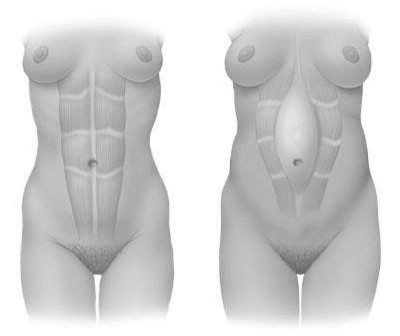We often hear mothers say that they have diastasis of the abdominal rectus or abdominal diastasis, which is the separation of the alba line of the famous six-pack. But, this doesn´t only occur in mothers during and after pregnancy, also to people who perform strenuous physical tasks as well as those who are overweight or obese.
-
What is diastasis of the rectus?
In the abdominal muscle group, we find a muscle known as the rectus abdominus. It is the muscle of the famous six-pack that is very appealing aesthetically and is well-defined in fitness enthusiasts and body-builders.
This muscle of the central part of the abdomen we can say is symmetrical from the middle point of the body and this middle point is connective tissue of the rectus, which is also known as the alba line. The line that splits the six-pack in the abdominal rectus.
This alba line is fibrous in texture and therefore cannot be stretched as with other structures. However, during pregnancy the abdominal girdle grows and the muscle stretches and separates to allow growth of the baby. In so doing, the fibrous membrane that joins the abdominal muscles is separated and thus there is a separation between the abdominal muscles, which turns this area into one at great risk of rupture.
-
What should you avoid if you have abdominal diastasis?
if you have abdominal diastasis or if you want to prevent it, you should avoid:
– Excessive weight gain, then this will help you to distend the connecting tissue of the abdominal muscle group.
– Avoid wrong postures that will increase pressure in the stomach. A good body alignment will help the abdominal firm and without unnecessary pressure.
– Avoid hyperpressive exercises or hyperpressure activities which are all those that increase pressure in the abdomen. Among this exercises we find: abdominals, sit-ups, planks, exercises requiring great strength like lifting heavy objects, running or jumping.
-
What can I do if I have abdominal diastasis?
If you have the slightest suspicion that you have diastasis of the abdominal rectus, consult with your health care provider.
A pelvic floor physiotherapist or a Low pressure fitness trainer can help you in this direction, both for the diagnosis as for the prescription of the best rehabilitation or preventive therapy. As much as if it is an anatomical diastasis as a functional one, it is recommended to perform physical therapy to improve the structures and to prevent future hernias. When the abdominal diastasis is very large, for example more than 4 cm, some individuals may need surgery. In my opinion, aside from the surgical option, planning to carry out a program based on exercise is the best preventive medicine.
Low Pressure Fitness, is an excellent tool for rehabilitate the abdominal structures. The strong myofascial traction that is generated during the exercises, the pelvic decongestion, the increase of abdominal tone and the decrease of intraabdominal pressure are some of the effects it will give to the abdominal wall. There are more and more cases of women in post-natal condition as well as athletic women who have submitted their abdominal girdle to excessive hyperpressive efforts that obtained stunning results with LPF exercises.


